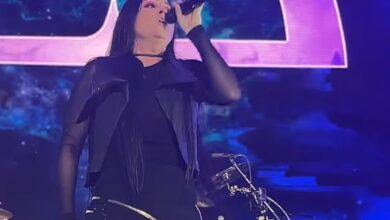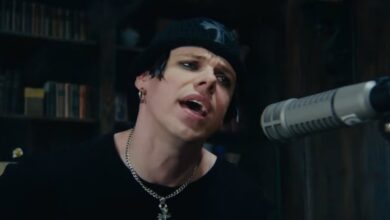Ace Frehley’s Legendary Twin-Guitar Masterclass: Detroit Rock City Live at Dodger Stadium
The night of October 31, 1998, wasn’t just another stop on KISS’s Psycho Circus Tour — it was an eruption of history, fireworks, and sonic precision at Dodger Stadium in Los Angeles. The stage was a city of flames, the makeup gleamed under the lights, and the anticipation was volcanic. The band was back in full original force — Paul Stanley, Gene Simmons, Peter Criss, and Ace Frehley — kicking off a new era with one of the most iconic live shows of their entire career.
When the opening riff of “Detroit Rock City” ripped through the speakers, the stadium didn’t just respond — it exploded. Tens of thousands of fans screamed the lyrics in unison as the pyrotechnics lit up the sky. But in the middle of that chaos came something almost transcendent — the dual guitar harmony between Ace Frehley and Paul Stanley, a moment so perfect it still sends chills down spines every time it’s heard. It wasn’t just tight musicianship; it was chemistry, instinct, and decades of brotherhood translated into melody.
The magic began during the instrumental break. Ace’s Les Paul cried with that signature tone — sharp, cosmic, and full of bite — while Paul’s rhythm guitar danced around it with surgical precision. Their harmonies intertwined like two voices singing one anthem. Fans often describe it as the greatest twin-guitar moment of all time, and it’s easy to understand why. The melody soared over the crowd like an electric storm, and when the two guitars locked together, the sound felt like pure adrenaline.
That harmony wasn’t just technically flawless — it was emotional. You could hear the history of the band in those notes. After decades of chaos, fame, and near collapse, this was KISS reminding the world what made them legends in the first place. Ace and Paul weren’t just playing; they were speaking a language that only they understood — one forged in rehearsal rooms, recording studios, and thousands of nights on the road.
As the song progressed, the visuals only amplified the moment. Flames erupted in time with each beat, Gene stomped across the stage breathing fire, and Peter’s drums thundered like cannons. But all eyes remained on the two guitarists in perfect synchronization. The moment Ace leaned toward Paul and they hit that melodic run together, the entire stadium seemed to levitate. That brief exchange — a flash of sound and light — became immortalized as one of the defining snapshots of live rock performance.
Even in bootleg recordings from that night, you can feel the energy bleeding through. The crowd’s roar almost drowns out the mix, yet the guitars cut through like lasers. There’s something alive in that harmony, something human. It’s not just about skill — it’s about connection. Ace’s slightly unhinged phrasing meets Paul’s precise control in a collision that somehow becomes perfect balance.
This performance also marked a symbolic victory lap. The band had reunited a few years prior, and Psycho Circus was meant to cement their legacy in a new millennium. Playing “Detroit Rock City” — the song that had always represented their essence — in front of a roaring Los Angeles crowd felt like destiny fulfilled. The performance was being broadcast worldwide, reminding fans everywhere that KISS wasn’t just a band. It was a spectacle, a ritual, a shared pulse.
Ace Frehley, ever the Spaceman, seemed untouchable that night. His solos were fluid, effortless, yet wild — balancing melody and mayhem in equal measure. Every phrase was unpredictable but right where it needed to be. His grin, that unmistakable mix of confidence and chaos, said it all: he was in complete control of the storm.
Paul Stanley, meanwhile, matched him with unrelenting charisma. His rhythm playing during the harmonized sections was the glue holding everything together. He didn’t just accompany Ace — he elevated him. The two traded glances throughout the song, communicating through nods and smiles. It was a partnership, not competition — two artists perfectly aware that together, they were unstoppable.
Fans who attended still describe it as a “once-in-a-lifetime” experience. Many said they could feel the guitar harmonies vibrate through the ground, shaking the bleachers and echoing in their chests. When the final chorus hit and fireworks erupted behind the KISS logo, it felt less like a concert ending and more like a universe collapsing in sound and light.
The performance would go on to become one of the most shared and replayed KISS moments online. Younger fans who hadn’t even been born in 1998 continue to discover it, often commenting that it’s “the greatest live guitar harmony ever recorded.” It’s not nostalgia — it’s recognition of musicianship so authentic, it transcends generations.
Now, in the wake of Ace Frehley’s passing, that performance carries a new kind of weight. Watching it today is no longer just thrilling — it’s bittersweet. The chemistry between Ace and Paul wasn’t just musical; it was spiritual. That night at Dodger Stadium, their guitars didn’t just play — they spoke, argued, and reconciled all at once.
Every sustained note Ace played feels different now. It’s no longer just the sound of KISS — it’s the sound of a man whose spirit burned brighter than the pyros behind him. The way his guitar soars through “Detroit Rock City” is now a permanent reminder of his genius. He was the spark in the chaos, the melody within the noise.
Ace Frehley and Paul Stanley’s dual guitar harmony at Dodger Stadium remains a masterclass in balance — flash and substance, chaos and control. The melody still sends chills down spines every time it’s heard — and honestly, there’s no debate about it. That night in 1998 wasn’t just a concert; it was a reminder that when two guitars sing in harmony, they can shake the heavens.
More than two decades later, fans still revisit that performance as proof that lightning doesn’t just strike once. It can strike twice, in perfect pitch, through the hands of two rock immortals who turned noise into art and made the world feel alive for seven unforgettable minutes.





